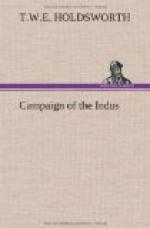We halted a day at Mostrong, which was about half way, and here General Willshire and the political agent communicated with the Khan, who replied, that “as to the terms, he was willing to meet General Willshire half way, with a small escort, and there talk them over; but that if we advanced against him with an army, he should shut his gates, and we should find him at the door of his citadel with his drawn sword.” There was “no mistake about that ’ere,” as Sam Weller would say. However, most of us thought it was merely bravado, as our progress was not molested at all; this, however, was afterwards accounted for by the Khan’s having called in all his fighting-men to his standard.
The last three days before arriving at Kelat we marched in order of battle, and had strong pickets at night, the whole force sleeping on their arms, and ready to fall in at a moment’s notice.
On the 12th we were within eight miles of the fort; and on our arriving on our ground a few horsemen were observed reconnoitring us, who fired on our advance, but retired leisurely on the approach of the column. By that hour the next day “Kelat was prize money.” We strongly expected to be attacked that night, and were all ready for a shindy; the artillery loaded with grape, and port-fires lighted, &c. However, it passed over very quietly; but we had hardly marched a mile from our encampment the next morning, when, in an opening through the hill to our right, we observed a large cloud of dust, which we soon discovered to be raised by a strong body of horsemen. They were about a mile and a half from our flank, and kept moving on in a parallel line with our column. However, at a point where the road took a turn towards the hills they halted, at about 150 yards from the advance guard, and deliberately fired into them with their matchlocks, but at too great a distance to do much harm. One company from the advance was sent to dislodge them; upon which they moved quickly down towards the main body, and taking up a position at about the same distance from us as before from the advance, gave us the same salute as they had before treated those in front to. Their balls came whistling in upon us on all sides, and knocked up the dust like drops of rain, but no damage was done; they then galloped off. It was a great pity we had no more cavalry with us; only fifty Bengal, or Irregular Horse, and their cattle were so done up that they were perfectly useless. The enemy laughed at the advance companies that were now sent out to skirmish with them. The ground consisted of undulating hills, and rather rough, over which our skirmishers, encumbered as they were with knapsacks and other absurdities, “selon les regles,” found it very difficult to move quickly, and the enemy, riding their sure-footed horses to the top of one of those hills, would fire down, and wheel round, and be under cover of the other side of the hill before our men could return the compliment effectually. If we had had a squadron of Dragoons




